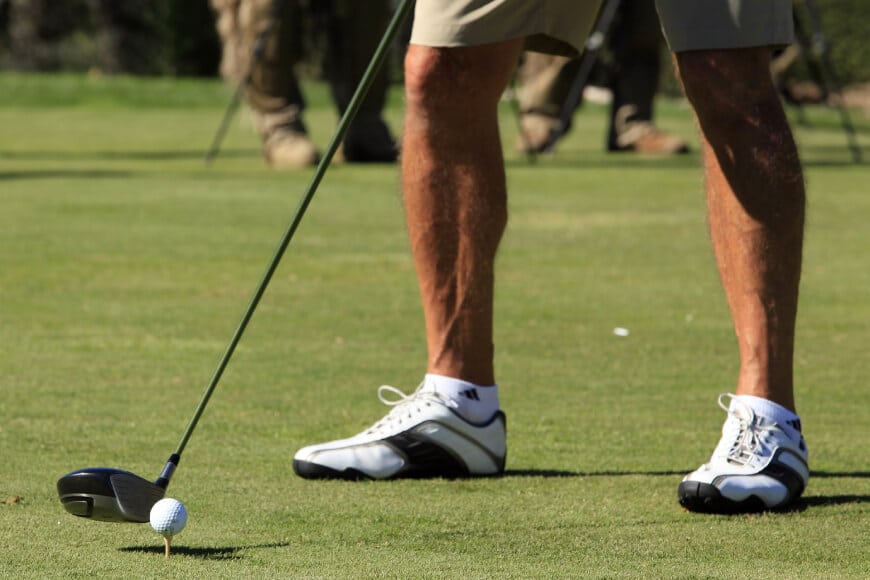Do rules rule in golf? Yes, it should prevail to keep every game well-organized and fun. But many golfers are not aware of some Rules of Golf. One of these is the standing astride. Most players consider this one of the worst golf rules in the game.
A standing astride is a putting stance with either foot touching across or the line of the putt. You shall not extend either foot on the line behind the ball. The rule is also clear that a player must not make a stroke from a stance with a foot deliberately placed on each side of the line of play.
That’s the rule!
Watch a video explaining a past golf tournament (RBC Heritage Golf) costing Dylan Frittelli two shots because of this violation:
We have more explaining to do about what standing astride in golf means. We will explain how it may cost you to lose two-stroke, etc. Continue reading so you know!
What Does Standing Astride Mean In Golf?

The Oxford dictionary defines astride as one leg on each side. Rule 16-1e of the USGA explains: a golfer should not make a stand astride while doing a stroke on the putting green.
The rule specifies that a golfer should not have a stance with either foot touching the line of the putt when making the stroke. The ruling also states that there should be no extension of the specified line behind the golf ball.
Rule 16.1e is a revision of Rule 16.1, stating that you cannot touch (or step) on your line of putting. This rule was eliminated in 2019, permitting golfers to straddle the line of putt while reading it.
Read More: Best Golf Balls for 95-100mph Swing Speed.
Possible “Repercussions” of Standing Astride
Not all violations of the standing astride have the same upshots. It highly depends on the round arrangement. In Dylan Fritelli’s case, the golfer has assessed a two-stroke penalty for standing astride in a tournament at the RBC Heritage in April 2022.
Fritelli’s tee ball rests in a hanging moss about six feet above the ground. Instead of declaring unplayable, the pro guy chooses to play where the ball lies.
Choking up the ball, Fritelli hit his ball 30 feet into the fairway; and knocked the third shot to 10 feet, sinking the putt to save par. Fritelli is more likely penalized per Rule 10.1c: making a hit while on the line of play or standing across the putting line.
When Is A Stand Astride Acceptable?
Yes, there is a justifiable stand stride in golf, as any rule does have exceptions. A player may not be penalized for the violation if he does not have the intention to do it. In other words, the circumstance might be accidental.
The USGA is not at all too restrictive on the standing astride rule. The association grants the use of standing astride in certain situations. And here is where the AimPoint system comes in (more about this later). Here are some exceptions where standing astride may not be illegal.
- When applying the AimPoint method in reading the contour of the ground.
- When a golfer determines the degree of slope using his feet.
- No penalty imposes on a golfer who accidentally takes a stance to avoid another line of putt.
- Straddling the line of putt when trying to find out the slope, not when doing a stroke.
How To Prevent Standing Astride?

The rule might be weird to some, but it is one of the simplest to follow. You only need to remember it every time you make a putt. You can prevent a standing stride by keeping your feet parallel to the ball and the target line.
We have more tips to keep your feet out of harm’s way. Here are some steps you may follow to prevent you from standing astride when putting.
- The Line of Putt is a virtual line a golfer desires the ball to take after a shot within the green. The putting line includes a sensible range on both sides of your calculated line. Remember that this line does not cover the hole and beyond, so you will avoid touching the boundaries of the putting line.
- Always keep your feet facing parallel to the target line and the golf ball.
- If you doubt your stance, remember to stride away from the ball at an appropriate distance; and make an address with your usual posture.
- Do not stand on another golfer’s line of putt or his expected line of putt.
- Always get hold of your usual stance when doing a putting shot.
- Your feet will not astride or touch the line when you never reach the hole and tap in the putt.
- Do not step on the line of the putt when doing the stroke.
Why Do Golfers Stand Astride on Their Putting Shots?
It has something to do with the AimPoint putting method. In some cases, golfers may find a way to fix inconsistencies in the greens. Golfers usually astride or straddle the putting line to help them figure out how a putt breaks into the green. The AimPoint is a putting style developed by Mark Sweeney, founder of AimPoint Golf.
The technique uses weight distribution between the golfer’s feet to evaluate the degree of inclination of the surface. It is an efficient approach to helping players in reading greens. The concept encourages the golfer to straddle or stand to know where the putt breaks. The method also interprets how grave the ground slope is.
The AimPoint is a slope reader using the feet, not the eyes. You do not need a machine to survey the playground.
What Is The Standing Astride Golf Penalty?
The previous USGA Rule 16.1 says that you cannot touch or obstruct your line of putt. This rule changed in 2019: the penalty is canceled for simply touching the line of play on the putting green. However, it is still not allowed to improve your line of play in the green, as per USGA Rule 18.1a.
In breaching golf rules, such as standing stride while stroking a putt, the outturn is General Penalty: It is either a loss of hole-in-match play or a two-stroke penalty in a stroke play. The latter was the penalty given to Dylan Fritelli under Rule 10.1c (taking a shot standing over or on the line of putt).
FAQ’s
You can stand behind the ball before doing the stroke (putt) but not when you are doing the putt. Rule 16-1e is clear: A golfer should not make a putt behind the ball on the putting line or its extension behind the ball.
The correct putting stance is placing your feet and body parallel to the intended line of putt. The illegal putting stance is when you do the putting stroke while standing on this putting line.
The standing astride stance becomes illegal when you are doing it when making the stroke.
It is not the cause of sweaty hands or anything about the grip. Golfers straddle the putting line to assess the degree of break (or slope) in the putt by feeling the earth with their feet. But they cannot straddle the line of putt when making the stroke.
You can do putt out-of-turn when a player is too far from the hole and is not ready to play (USGA Rule 10). The player concerned can ask you to do your putt while he is not ready yet.
USGA Rule 10.2b suggests that your caddy should not stand behind you along the line of putt when making the stroke. However, the USGA and R&A did some exceptions to this rule.
For example, a caddy may stand behind a golfer holding a sunshade or umbrella until the time to hit the shot. The R&A and USGA allowed these exceptions as long as the golfer is not using the situation to his advantage.
Yes, every golfer should know this technique. Currently, more than 75,000 golfers worldwide are using AimPoint (about 5,000 of these are junior golfers). Also, about 200 professional golfers are using the system in their tournaments.
Some popular pros using the AimPoint method are Justin Rose, Ben Crane, Brian Gay, and Adam Scott. Furthermore, more than 300 golf instructors include AimPoint in their lectures.
Conclusion
So, what is standing astride in golf? What you know will not harm you. Instead, it will make you more cautious in your game.
Now you know the ways to avoid standing astride when making a stroke and the consequences it may bring. This rule is one of the simplest regulations in the rules of golf. You only have to keep your feet parallel to your line of the putt and the target line. As simple as that, indeed!
Read more: What Does WD Mean In Golf?
Matt Stevens is the founder of Golfrough.com. He holds a Postgraduate in Sports Marketing and has played golf since he was four years old. Having experienced every high and low golf has to offer, his writing helps the average golfer avoid the mistakes he has made in 28-years on the course.

